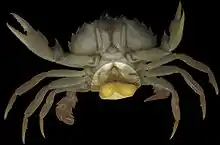Sacculina carcini
Sacculina carcini, the crab hacker barnacle,[2] is a species of parasitic barnacle in the family Sacculinidae, in particular a parasitic castrator, of crabs. The crab that most often is used as a host is the green crab, the natural range of which is the coasts of Western Europe and North Africa.[2] It can be found attached to the crab's abdomen and affect consumption rates by humans.[3]
| Sacculina carcini | |
|---|---|
 | |
| S. carcini (highlighted) attached to a female Liocarcinus holsatus crab | |
| Scientific classification | |
| Kingdom: | |
| Phylum: | |
| Subphylum: | |
| Class: | |
| Order: | |
| Family: | |
| Genus: | |
| Species: | S. carcini |
| Binomial name | |
| Sacculina carcini | |
| Synonyms | |
|
List
| |
Appearance
The Sacculina carcini differ greatly between males and females. The female barnacles look like small slugs before they reach the crab. Once they have infected their host, they begin to develop and grow tendrils.[3] This allows them to get the nutrients that it needs from their host. Over time, it can be seen hanging off the crab's abdomen filled with reproductive tissue. The male parasites are much smaller and serve only to help the female Sacculina carcini reproduce.[3]
Distribution and habitat
S. carcini is a monoxenic parasite of crabs, most commonly the green crab (Carcinus maenas). They have also been found to infect the Carcinus aesturarii, Liocarcinus depurator (Harbour crab), Pirimela denticulata, Necora puber (Velvet crab), and the Liocarcinus holsatus (Flying crab).[2][3] The parasite's range largely coincides with that of this host, which is usually the coasts of Western Europe and North Africa. The green crab, however, has been expanding its range and has become established in both North and South America, Southern Africa and Australia, so it is possible that the parasite is now present outside its natural territory.[3] These crabs all live in shallow water over sandy, rocky, or muddy substrates.[2]
Life cycle
A female Sacculina carcini larva settles on a suitable crab host and crawls across its surface until it finds a suitable spot such as the base of a seta (bristle). It then develops into a form called a kentrogon, which inserts a stylet into the crab and pushes its way inside. In order to do this, she has to shed her outer hard shell first.[4] From there it moves through the inside of the crab, in due course pushing out a sac, known as an externa, on the underside of the crab's abdomen. The part remaining inside, the interna, develops tendrils which spread throughout the crab. They take over the stomach, intestines, and nervous system to absorb nourishment and enable the parasite to control the behavior of its host.[5][6]
The presence of the parasite inhibits the development of the crab's gonads, which eventually atrophy; it also prevents the crab from molting, consequently preventing it from regenerating lost limbs. The parasite causes a male crab to develop certain feminine characteristics including the broadening of its abdomen,[7] while in females, the abdomen becomes narrower and the pleopods degenerate. The eggs of the parasite develop in the externa and both male and female crabs carry these eggs around, secured under their abdomen, in the way that female crabs normally care for their own brood (but males never do). If the parasite is experimentally removed from the host, female crabs will usually regenerate their ovaries, but in males, sex change takes place and they develop ovarian tissue.[6]
The eggs inside the externa are fertilized by male larvae which enter the sac through a pore. These males are tiny, never become adults and soon die. However, the female, including the externa, can live for as long as the crab host survives, perhaps one or two years.[4] Hundreds of eggs are produced every day and remain in the sac for about six weeks. When the parasite eggs are ready for release, the crab will climb onto a rock, bob about to release them and waft them on their way.[4] The cycle then continues with each generation.
Human impacts
The Sacculina carcini is known to control the population size of their hosts, like the Green crab, by making many of them infertile. Without reproduction, the population cannot expand and can cause a shortage for human consumption. The parasite can also cause their hosts to stop molting once infected. This can cause the crab to stop growing before it reaches a size big enough for human consumption.[3]
References
- Boyko, Christopher B. (2015). "Sacculina carcini Thompson, 1836". WoRMS. World Register of Marine Species. Retrieved 13 January 2018.
- Hosie, A.M. (2008). "Crab hacker barnacle (Sacculina carcini)". MarLIN. Archived from the original on 15 January 2018. Retrieved 14 January 2018.
- Jeng, Winnie (2011). "Sacculina carcini". Animal Diversity Web. Archived from the original on 10 May 2017. Retrieved 14 January 2018.
- Melissa (7 October 2013). "The Parasitic Sacculina That Bends Its Host to Its Own Will". Today I found out. Archived from the original on 14 September 2017. Retrieved 13 January 2018.
- Leung, Tommy (13 May 2014). "The crab-castrating parasite that zombifies its prey". The Conversation. Archived from the original on 14 January 2018. Retrieved 13 January 2018.
- Cheng, Thomas C. (2012). General Parasitology. Elsevier Science. pp. 756–757. ISBN 978-0-323-14010-2. Archived from the original on 2018-02-08.
- Kristensen, Tommy; Nielsen, Anders Isberg; Jørgensen, Anders Isak; Mouritsen, Kim N.; Glenner, Henrik; Christensen, Jens T.; Lützen, Jørgen; Høeg, Jens T. (2012-09-01). "The selective advantage of host feminization: a case study of the green crab Carcinus maenas and the parasitic barnacle Sacculina carcini" (PDF). Marine Biology. 159 (9): 2015–2023. doi:10.1007/s00227-012-1988-4. ISSN 1432-1793. S2CID 53379322.
External links
| Wikimedia Commons has media related to Sacculina carcini. |